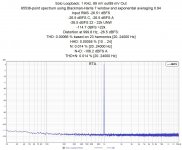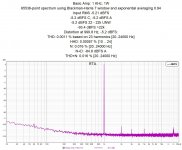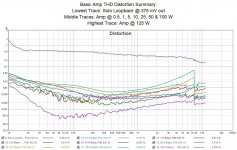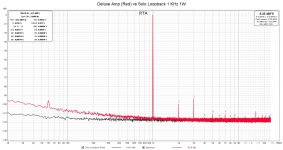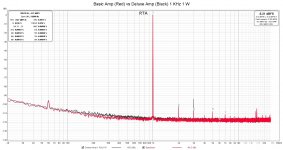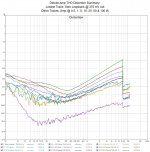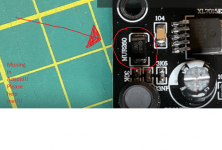I'll try to explain part of what you are hearing.I just received Shui Yuan TPA3255. It's cost around $29 including the shipping cost and tax to Indonesia
I tried to power up the amplifier with SMPS power supply : Omron S8FS-C10024 (24v 4.5A) and after 1 hour then I try to switch with Autonics SPA-100-24(24v 4.2A).
I'm not sure why the fault LED and clip LED always light on. Is it normal?
With Omron, I set the voltage from 22.5 up to 28.5v and I can hear the difference when the voltage changed. Higher voltage will give wider soundstage. then I try to switch the power supply with Autonics, and I can hear the difference with Omron. The lower sound, the bass is little bit punchy with Autonics.. maybe the Autonics output has less noise? I don't have any tools to measure the ripple so I'm not sure why Autonics sound better.
After listening 2-3 hour, I can say this 'raw' unmodified version sounds better than some Chinese TPA3116 board I ever heard. I also have myRefC amp (class AB) with boutique components, FH9 (class AB) , FX8 amp (class A) and this TPA3255 amp sound so good in my ear.
I have OPA2134 to test. after rolling the op amp, this amplifier sound more pleasant, more 'musical' to my ears
First, it was covered early in this thread that the lights remain on when it is functioning properly, so do not worry about the lights being on. It is normal.
Second, wattage supply is W=V*I (with I being current/amps). So, doing the math on base specs, the Omron is rated for 110.25W and the Autonics is rated for 100.8W. So, how loud it can play is effected on the math, with the Omron being 10% more power able to be supplied.
The Autonics having a lower noise floor/ripple is a distinct possibility, although at the wattage on both power supplies, I'm unsure of the audibility of the noise (but, that is noise, which does not account for all reproduction in the signal and a cleaner signal, regardless of the noise floor, would sound more transparent and vivid (note- I am not from the audiophile community, so the descriptions used, which vary person to person, is not something I do; I'm a data driven person so I can explain phenomena through observed data, then try to compare what my ears are hearing to what data I see from analysis with different tools)).
So, I have previously seen described that as you increase the voltage while driving these amps, it will overcome certain noisier components in the chain. One person reported having a cleaner signal above a certain voltage, but I cannot remember where I read that and if it was for this or the 3E variant. In any case, this is likely why the 28.5V helped open up the sound stage.
As for the rest, once I hear back on the caps that are on the back of my board, I'll place that order then I can give more firm data. I also have ordered an RD6012P-W Bench Power Supply. https://www.aliexpress.com/item/1005003472332331.html
This bench power supply has a low ripple value of 20mV, while also having power up to 720W out. I got something with that much power to accurately program and test at different voltage values and ability to limit wattage to see the effects on the amplifier at various wattage.
I have a theory on it maybe being related to output capacitance on the two power supplies regarding punchier bass (with maybe the autonics having more capacitance and when driving the amp at the edge of what the power supplies can supply, and with bass asking for more watts than other frequencies, that the power supply output stage capacitors are being drained quickly, thereby running out of supply when requested causing the bass on one to sound thinner and less punchy than the other), but this is a hypothesis at this point only. There are too many variables I do not know to fully account for everything.
But I am glad you are liking what you are hearing.
So, except for a handheld oscilloscope reading, I've seen practically no measurements. Is there a reason people do not measure?
Here are a few measurements I made of the Shui Yuan TPA3255 amplifier. Three amp versions were available when I ordered the amp from AliExpress in September 2021: basic, middle and deluxe. This is the basic version with NE5532P op amps and standard (not Nichicon) capacitors. Currently only the basic and deluxe versions are available (LINK).
My measurement setup consists of an old Dell workstation laptop running on battery, a 3rd gen Focusrite Solo USB audio interface powered by the laptop and a set of 4 Ohm Arcol 50 W power resistors mounted on a heatsink. I also have a symmetrical voltage divider that is adjustable in 6 dB steps and connects between the amp’s output and the Solo’s input. The divider lets me test at different power levels without changing the Solo’s input gain.
I used a Mean Well LRS-350-36 power supply. This amp can support higher voltages and generate more power, but I plan on using a 36 V supply. According to the TI datasheet the TPA 3255 should be able to output 125W @ 1% THD into 4 ohms with 36V. All tests were both channels driven into 4 ohm loads.
I first measured both channels @ 1 KHz to determine the amp’s gain and inter-channel offset. The gain was 27.4 dB and the two channels differed only by 5 mV. The first attachment shows the Solo’s loopback performance with a 1 KHz input @ 89 mV output. The output value was chosen as it generates 1W when applied to the amp. The second attachment shows the amp’s 1W response. The last attachment is a summary of the amp’s THD at various power levels.
Attachments
Yes...
I'm not sure why the fault LED and clip LED always light on. Is it normal?
Thank you! This is excellent information and definitely adds to seeing what is happening with the amplifier.Here are a few measurements I made of the Shui Yuan TPA3255 amplifier. Three amp versions were available when I ordered the amp from AliExpress in September 2021: basic, middle and deluxe. This is the basic version with NE5532P op amps and standard (not Nichicon) capacitors. Currently only the basic and deluxe versions are available (LINK).
My measurement setup consists of an old Dell workstation laptop running on battery, a 3rd gen Focusrite Solo USB audio interface powered by the laptop and a set of 4 Ohm Arcol 50 W power resistors mounted on a heatsink. I also have a symmetrical voltage divider that is adjustable in 6 dB steps and connects between the amp’s output and the Solo’s input. The divider lets me test at different power levels without changing the Solo’s input gain.
I used a Mean Well LRS-350-36 power supply. This amp can support higher voltages and generate more power, but I plan on using a 36 V supply. According to the TI datasheet the TPA 3255 should be able to output 125W @ 1% THD into 4 ohms with 36V. All tests were both channels driven into 4 ohm loads.
I first measured both channels @ 1 KHz to determine the amp’s gain and inter-channel offset. The gain was 27.4 dB and the two channels differed only by 5 mV. The first attachment shows the Solo’s loopback performance with a 1 KHz input @ 89 mV output. The output value was chosen as it generates 1W when applied to the amp. The second attachment shows the amp’s 1W response. The last attachment is a summary of the amp’s THD at various power levels.
Here are a few more Shui Yuan amp measurements. These are for the “deluxe” version of the amp that’s available from AliExpress (LINK). Here are the amp differences as listed on the web page:
“Basic version: use NE5532P op amp+3200uF/63v capacitor
Deluxe version: use LME49720NA operational amplifier + nichicon FW 2200uF/63v fever audio electrolytic capacitor + WM capacitor”
I used the same measurement setup and power supply as in my previous post (#442). I first measured both channels @ 1 KHz to determine the amp’s gain and inter-channel offset. The gain was 27.5 dB and the two channels differed by 10 mV.
The first attachment shows the amp’s 1W response compared to the Solo’s loopback response (see my previous post for the Solo’s loopback response alone). The second attachment compares the 1W response for the basic and deluxe versions. The unexpected result is the deluxe version shows higher levels of 3rd harmonic distortion. The third attachment is a THD distortion summary at various power levels (I forgot to test at 125 W as I did for the basic version).
So what’s causing the higher 3rd order harmonic in the deluxe version? At first I doubted my results so I repeated both the basic and deluxe tests several different times. No change in results. Next I thought of the popular “fake Chinese op-amps” scenario. So I ordered some LME49720NA op-amps directly from Mouser and tried those. No change in results. Finally I thought that perhaps the PCB layout and/or components favored the characteristics of the NE5532P op-amps. So I removed the NE5532P op-amps from the basic amp and installed them in the deluxe version. No change in results. At that point I stopped my diagnosis.
The more important question is whether the amps sound different. To be fair, the deluxe version’s 3rd harmonic distortion is still more than 90 dB below the carrier. And some people report that amps with slightly more 3rd harmonic distortion sound more “detailed” and “open”. Unfortunately I haven’t had the time or motivation to perform a blind comparison of the two amps. Other projects have taken priority and my use case for these amps will be as a woofer amp for a three way. In that situation I really don’t think I personally would hear any difference. YMMV.
“Basic version: use NE5532P op amp+3200uF/63v capacitor
Deluxe version: use LME49720NA operational amplifier + nichicon FW 2200uF/63v fever audio electrolytic capacitor + WM capacitor”
I used the same measurement setup and power supply as in my previous post (#442). I first measured both channels @ 1 KHz to determine the amp’s gain and inter-channel offset. The gain was 27.5 dB and the two channels differed by 10 mV.
The first attachment shows the amp’s 1W response compared to the Solo’s loopback response (see my previous post for the Solo’s loopback response alone). The second attachment compares the 1W response for the basic and deluxe versions. The unexpected result is the deluxe version shows higher levels of 3rd harmonic distortion. The third attachment is a THD distortion summary at various power levels (I forgot to test at 125 W as I did for the basic version).
So what’s causing the higher 3rd order harmonic in the deluxe version? At first I doubted my results so I repeated both the basic and deluxe tests several different times. No change in results. Next I thought of the popular “fake Chinese op-amps” scenario. So I ordered some LME49720NA op-amps directly from Mouser and tried those. No change in results. Finally I thought that perhaps the PCB layout and/or components favored the characteristics of the NE5532P op-amps. So I removed the NE5532P op-amps from the basic amp and installed them in the deluxe version. No change in results. At that point I stopped my diagnosis.
The more important question is whether the amps sound different. To be fair, the deluxe version’s 3rd harmonic distortion is still more than 90 dB below the carrier. And some people report that amps with slightly more 3rd harmonic distortion sound more “detailed” and “open”. Unfortunately I haven’t had the time or motivation to perform a blind comparison of the two amps. Other projects have taken priority and my use case for these amps will be as a woofer amp for a three way. In that situation I really don’t think I personally would hear any difference. YMMV.
Attachments
I've actually seen the opposite regarding third harmonics. The easy way to think of it is even harmonics are less harsh to the ear than odd harmonics, meaning 3d order harmonics actually is much more discordant than second. But, intermodulation distortion is more audible than THD+N. This is because it is not tied to harmonics at all and can shoot through the music which provides cover for harmonic distortion.Here are a few more Shui Yuan amp measurements. These are for the “deluxe” version of the amp that’s available from AliExpress (LINK). Here are the amp differences as listed on the web page:
“Basic version: use NE5532P op amp+3200uF/63v capacitor
Deluxe version: use LME49720NA operational amplifier + nichicon FW 2200uF/63v fever audio electrolytic capacitor + WM capacitor”
I used the same measurement setup and power supply as in my previous post (#442). I first measured both channels @ 1 KHz to determine the amp’s gain and inter-channel offset. The gain was 27.5 dB and the two channels differed by 10 mV.
The first attachment shows the amp’s 1W response compared to the Solo’s loopback response (see my previous post for the Solo’s loopback response alone). The second attachment compares the 1W response for the basic and deluxe versions. The unexpected result is the deluxe version shows higher levels of 3rd harmonic distortion. The third attachment is a THD distortion summary at various power levels (I forgot to test at 125 W as I did for the basic version).
So what’s causing the higher 3rd order harmonic in the deluxe version? At first I doubted my results so I repeated both the basic and deluxe tests several different times. No change in results. Next I thought of the popular “fake Chinese op-amps” scenario. So I ordered some LME49720NA op-amps directly from Mouser and tried those. No change in results. Finally I thought that perhaps the PCB layout and/or components favored the characteristics of the NE5532P op-amps. So I removed the NE5532P op-amps from the basic amp and installed them in the deluxe version. No change in results. At that point I stopped my diagnosis.
The more important question is whether the amps sound different. To be fair, the deluxe version’s 3rd harmonic distortion is still more than 90 dB below the carrier. And some people report that amps with slightly more 3rd harmonic distortion sound more “detailed” and “open”. Unfortunately I haven’t had the time or motivation to perform a blind comparison of the two amps. Other projects have taken priority and my use case for these amps will be as a woofer amp for a three way. In that situation I really don’t think I personally would hear any difference. YMMV.
But, your numbers confirm what many have discussed regarding op-amps and swapping components, as far as is seen in FFT analyses, do not seem to significantly effect the frequency of the signal. The only other way to test this after seeing the electrical signal is to show it through using a calibrated microphone and showing that the speaker's reproduction is not changed from the change (which arguably is a useless endeavor because if you are not effecting the signal in the audible range with the amplifier through these changes, then any audibility of a change not seen in the signal is a bit dubious).
On another note, I finally got the information on the broken caps on the backside of my boards. 1uF 50V. So, I looked for the most stable I could get in that spec for 1206/1210 case size. I settles on C1210C105J5NAC7800. It is a ceramic capacitor with X8L dielectric, 1210 case (original case was 1206, so these are wider, but they can solder to the same contact pads because the length is the same), 5% tolerance, made for high temp (since this is on the underside of the TPA3255, which has an operating junction over 100C (especially with under powered heatsinks). Maybe a bit overkill on the component (which costed significantly more than the caps it replaces), but that's ok. This isn't swapping components hoping for improvement, it is replacing damaged components, so might as well go for something relatively stable.
I seriously need to get a good bench LCR Meter or LCR bridge to start testing components. But that is a different discussion.
I try to change reservoir capacitor with Nichicon KW 4700uF 50v, the dimension fit with space available. I can't hear the difference. but when power supply switched off, the amplifier still playing music at least 5seconds.maybe need some time to warm up the capacitor
Last edited:
Hi cloud I use Shui Yuan kit for a 4ohm subwoofer? I should use one channel instead of two because of stereo kit. Will I have any problem using one channel all the time? Thanks
I already have shui yuan kit and I thought don't buy another mono amp.Why use a stereo amplifier for the sub, when there are mono amps just for the sub?
It's not easy. Subwoofer is single coil and board is btl. It is totally wrong to use one channel for subwoofer?Or double coil sub...Or moder your card in PBTL.
Last edited:
Short circuit the unused input and connect a power resistor to the output.
or buy a second sub. 🙂
or buy a second sub. 🙂
4700uf????? Why????View attachment 1036386
I try to change reservoir capacitor with Nichicon KW 4700uF 50v, the dimension fit with space available. I can't hear the difference. but when power supply switched off, the amplifier still playing music at least 5seconds.maybe need some time to warm up the capacitor
The output capacitors value is supposed to be 2200uf, for what reason you increased it so much???
You should be glad nothing damaged from such a huge increase
@bankroll1972: Why so aggressive? We're dealing with safe low voltage here. As long as the polarity of the caps was observed, there shouldn't be any damage whatsoever. I mean in PSUs, 200% capacity should never do any harm whenever basic rules of electrical engineering are kept.
I didn't mean to come across as aggressive, but I get nervous seeing stuff like that posted online because someone who wanders here from Google and doesn't know what they are doing might see a picture like that, and make an incorrect assumption about the safety of changing capacitance values, I know it's not like these devices have mains power anywhere but still I worry.@bankroll1972: Why so aggressive? We're dealing with safe low voltage here. As long as the polarity of the caps was observed, there shouldn't be any damage whatsoever. I mean in PSUs, 200% capacity should never do any harm whenever basic rules of electrical engineering are kept.
My apologies if I over -reacted.
- Home
- Amplifiers
- Class D
- Shui Yuan Audio TPA3255 Modification Thread
